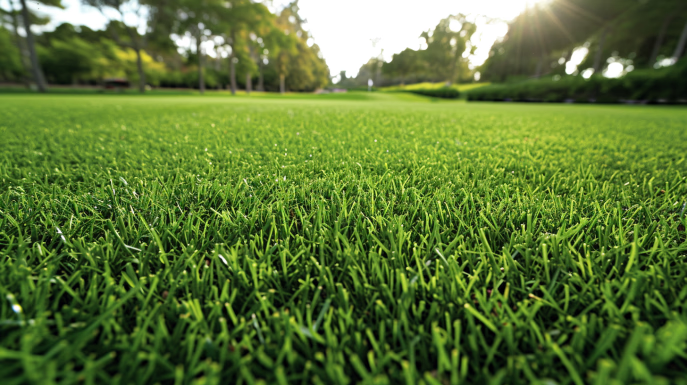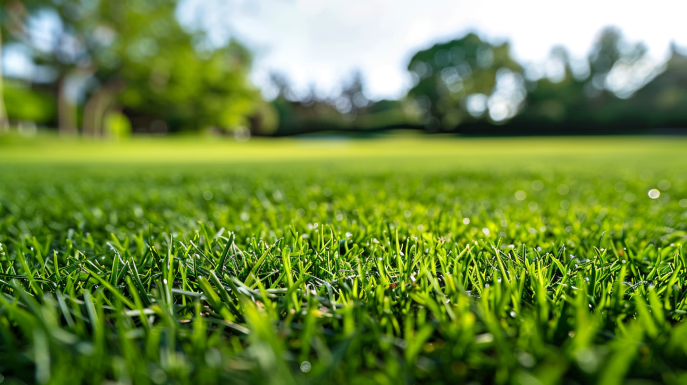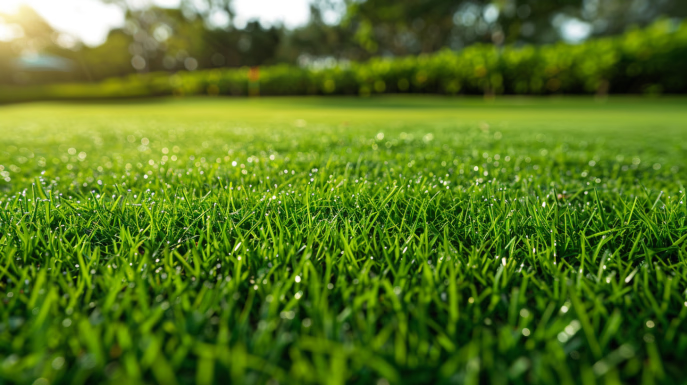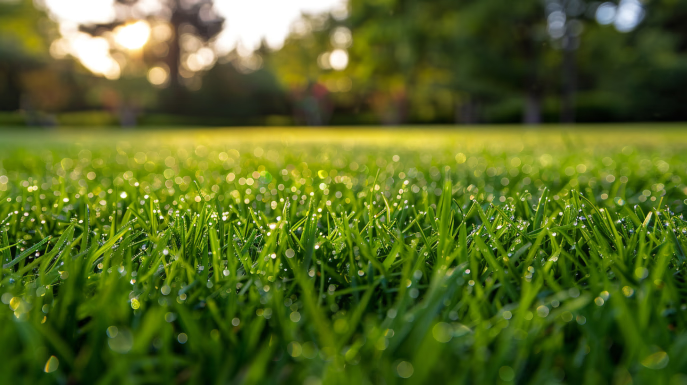Golf Course Turf: Essential Turf Care Techniques

Source : pinnaclegolfpros copyright
Golf course turf management is a complex and multifaceted discipline that requires a deep understanding of turfgrass biology, soil science, and environmental factors. Maintaining a high-quality golf course playing surface demands a comprehensive approach that addresses various aspects of turf care, from mowing and irrigation to aeration and pest management.
Groundskeepers must meticulously manage the grass types, soil health, watering practices, and fertilization strategies to ensure the turf density, playability, and aesthetic appeal of the course. Effective pest control and disease management techniques are also critical to maintaining a healthy, resilient playing surface that can withstand the demands of golfer traffic and weather adaptation.
Proactive aeration, dethatching, and overseeding practices help to promote strong root systems and ensure the long-term viability of the turf. Meanwhile, innovative irrigation systems and moisture management strategies play a pivotal role in optimizing turf nutrition and course aesthetics.
Ultimately, successful golf course turf management requires a delicate balance of traditional techniques and cutting-edge technology, all while prioritizing sustainable practices and minimizing the environmental impact of maintenance operations. By staying attuned to the latest industry trends and best practices, groundskeepers can create a playing surface that exceeds the expectations of both avid golfers and eco-conscious stakeholders.
Key Takeaways
- Comprehensive turf management requires a deep understanding of turfgrass biology, soil science, and environmental factors.
- Effective mowing, irrigation, aeration, and pest control techniques are essential for maintaining a high-quality playing surface.
- Proactive practices like overseeding and dethatching promote strong root systems and long-term turf health.
- Innovative irrigation systems and moisture management strategies optimize turf nutrition and course aesthetics.
- Sustainable practices and minimizing environmental impact are crucial considerations in modern golf course management.
Understanding the Unique Challenges of Golf Course Turf

Golf course turf faces distinct challenges compared to other turfgrass environments. The high-traffic conditions caused by golfer footsteps, cart traffic, and golf club impacts can lead to significant wear and compaction, compromising the turf’s density, health, and ability to recover. Maintaining optimal playability, which refers to the desired ball roll, bounce, and overall playing experience, is a critical objective for golf course superintendents.
High-Traffic Conditions and Wear Tolerance
The constant foot traffic and cart usage on golf courses subject the turf to a level of wear and tear that is far more demanding than what is encountered in residential or commercial landscapes. Superintendents must carefully manage the turf density and disease resistance to ensure the playing surface can withstand the high golfer traffic and maintain its integrity throughout the season.
Maintaining Optimal Playability and Aesthetics
Alongside managing the physical demands on the turf, golf course superintendents must also prioritize the playability and aesthetics of the course. This involves striking a delicate balance between maintaining a lush, uniform playing surface and mitigating the effects of soil compaction and turf recovery challenges. Achieving this level of precision is essential for delivering the high-quality playing experience that golfers expect.
| Turf Characteristic | Importance for Golf Course |
|---|---|
| High-Traffic Tolerance | Essential for withstanding the constant foot traffic and cart usage on the course. |
| Wear Resistance | Crucial for maintaining the integrity of the playing surface under the demands of golf play. |
| Turf Density | Contributes to the overall playability and aesthetics of the course. |
| Disease Resistance | Helps the turf withstand the challenges of the golf course environment and maintain its health. |
| Soil Compaction Resistance | Enables the turf to recover from the impacts of high traffic and maintain optimal playing conditions. |
| Turf Repair Ability | Crucial for addressing any damage or bare spots that may occur on the playing surface. |
Selecting the Right Turfgrass Varieties
Selecting the appropriate turfgrass varieties is a crucial step in establishing and maintaining a successful golf course turf. Golf course superintendents must carefully consider the local climate, environmental conditions, and maintenance requirements when choosing the right grasses for their course. The selection of turfgrass varieties plays a vital role in ensuring the desired turf density, disease resistance, and overall adaptation to the specific environmental conditions of the golf course.
Climatic Considerations for Turf Selection
One of the primary factors in turf selection is the local climate. Golf courses in different regions may require cool-season grasses or warm-season grasses based on the prevailing environmental conditions. Cool-season grasses, such as Kentucky bluegrass, perennial ryegrass, and fescues, thrive in temperate climates with cooler summers and milder winters. Warm-season grasses, including bermudagrass, zoysiagrass, and buffalograss, are better suited for warm, humid, and subtropical regions.
Golf course superintendents must carefully evaluate the adaptation of specific turfgrass varieties to the local environmental conditions, ensuring they can withstand the challenges posed by factors such as temperature extremes, precipitation patterns, and sunlight exposure.
Balancing Turf Density and Disease Resistance

In addition to climate considerations, golf course superintendents must also strive to achieve the optimal turf density and disease resistance characteristics for their course. Highly dense turf can provide a consistent, high-quality playing surface, but it may also be more susceptible to certain diseases. Conversely, turfgrass varieties with enhanced disease resistance may sacrifice some turf density.
By carefully selecting a combination of turfgrass varieties with complementary traits, golf course managers can create a playing surface that balances turf density and disease resistance, ensuring the long-term health and playability of the course.
Soil Health and Nutrient Management
Maintaining healthy, nutrient-rich soil is fundamental to the success of a golf course’s turf management program. Regular soil testing and pH monitoring are essential for understanding the soil’s composition, identifying any nutrient deficiencies , and implementing targeted fertilization strategies.
Soil Testing and pH Monitoring
Comprehensive soil analysis provides golf course superintendents with valuable insights into the soil composition , including the levels of essential nutrients, organic matter , and overall
soil structure . By regularly testing the soil, course managers can pinpoint any nutrient imbalances or deficiencies and take corrective action through the application of soil amendments or targeted fertilization.
Fertilization Strategies for Optimal Turf Growth
Crafting effective fertilization strategies is crucial for promoting robust turfgrass growth and maintaining the overall soil health . Golf course superintendents must carefully consider the nutrient cycling within the soil, the specific needs of the grass species , and the desired turf density and appearance . By integrating organic matter and strategic fertilization techniques, they can ensure the soil microorganisms and nutrient availability support the optimal growth and resilience of the turf.
| Soil Health Indicator | Optimal Range | Potential Issues |
|---|---|---|
| Soil pH | 6.0 – 7.0 | Nutrient deficiencies, poor turf growth |
| Organic Matter | 3% – 6% | Compaction, poor drainage, nutrient imbalances |
| Nitrogen (N) | 0.5% – 1.0% | Excessive growth, thatch buildup, environmental impact |
| Phosphorus (P) | 0.1% – 0.3% | Poor root development, reduced disease resistance |
| Potassium (K) | 0.3% – 0.6% | Drought stress, reduced cold tolerance, disease susceptibility |
Irrigation and Water Conservation Techniques
Effective irrigation management is a crucial aspect of golf course turf care, as it directly impacts the health, playability, and overall appearance of the course. Golf course superintendents must implement efficient irrigation systems and develop strategic irrigation scheduling practices to ensure the optimal delivery of water to the turf.
Efficient Irrigation Systems and Scheduling

Utilizing advanced irrigation systems, such as those with soil moisture sensors and weather-based controllers, can significantly improve water efficiency and reduce water usage on golf courses. Incorporating irrigation scheduling techniques, like evapotranspiration-based watering, can help golf course superintendents precisely match water application to the turf’s specific needs, minimizing drought stress and promoting healthy, resilient grass.
Drought Tolerance and Moisture Management
Selecting drought-tolerant turfgrass varieties and implementing water conservation strategies, such as soil moisture monitoring and mulching, can greatly enhance the moisture management capabilities of golf course turf. Additionally, implementing sustainable irrigation practices, like water recycling and groundwater recharge, can help golf course superintendents manage water resources effectively and reduce the environmental impact of their operations.
| Irrigation Technique | Water Efficiency | Maintenance Considerations | Environmental Impact |
|---|---|---|---|
| Evapotranspiration-based Scheduling | High | Requires soil moisture sensors and weather data integration | Reduced water usage, improved groundwater recharge |
| Soil Moisture Monitoring | Moderate | Regular soil testing and data analysis | Targeted irrigation, reduced water waste |
| Drought-tolerant Turfgrasses | High | Adaptations to local climate, potential for increased maintenance | Lower water demand, improved resilience to drought |
| Water Recycling and Groundwater Recharge | High | Requires specialized infrastructure and maintenance | Reduced freshwater withdrawals, enhanced water quality |
Mowing Practices for Healthy Turf
Proper mowing practices are essential for maintaining the health and appearance of golf course turf. Golf course superintendents must carefully consider factors such as mowing height, mowing frequency, and mowing patterns to promote optimal turf growth, turf density, and recovery from wear and tear.
Adjusting the mowing height can significantly impact the turf health and aesthetics of the playing surface. A higher mowing height can encourage deeper root development, improve wear tolerance, and create a lush, uniform appearance. Conversely, a lower mowing height may enhance ball roll and putting speed, but it can also stress the turf and make it more vulnerable to drought and disease.
The mowing frequency is another critical factor in maintaining healthy turf. Frequent mowing, coupled with clipping management, can help promote turf density and growth, as well as prevent the buildup of excess thatch. Superintendents must strike a balance between mowing frequency and grass growth rates to ensure the turf remains vibrant and resilient.
Additionally, the mowing patterns employed on the golf course can have a significant impact on turf health and aesthetics. Alternating mowing directions, such as vertical and horizontal patterns, can help prevent grain development and create a visually appealing, striped appearance. Proper clipping management, including timely removal or mulching, can also contribute to overall turf health by returning valuable nutrients to the soil.
Aeration and Dethatching for Root Development
Maintaining a healthy, thriving golf course turf requires a steadfast commitment to essential management practices, including aeration and dethatching. These techniques play a vital role in promoting robust root development, a key factor in the overall quality and longevity of the playing surface.
Core Aeration Methods and Timing
One of the most effective means of improving soil oxygenation and water infiltration is through the process of core aeration. This practice involves mechanically removing small plugs of soil from the turf, creating channels that allow for the air movement and nutrient uptake essential for turf health and recovery. Golf course superintendents must carefully time core aeration to coincide with periods of active growth, ensuring the turf has the best opportunity to heal and thrive.
Dethatching for Improved Air and Water Movement
Alongside aeration, dethatching is a crucial technique for maintaining optimal soil porosity and water infiltration. Thatch, the accumulation of dead and decaying plant material, can impede the flow of air and water, leading to soil compaction and compromised root development. By removing this built-up thatch layer, dethatching improves the overall turf health and supports the recovery process, setting the stage for successful overseeding and topdressing efforts.
| Aeration Technique | Key Benefits |
|---|---|
| Core Aeration |
|
| Dethatching |
|
Overseeding and Turf Renovation Strategies
Maintaining a thriving, high-quality golf course turf requires a multifaceted approach, and overseeding and turf renovation are essential strategies in this endeavor. Overseeding, the process of introducing new grass seed into an existing turf, can help fill in bare spots, improve density, and enhance the overall appearance and performance of the playing surface.
Overseeding and Turf Renovation Strategies
Golf course superintendents must carefully consider factors such as seed selection, seed blends, and soil preparation when implementing overseeding programs. Choosing the right turfgrass varieties that are well-suited to the local climate and maintenance requirements is crucial for successful establishment and long-term transition. Proper soil preparation, including aeration, topdressing, and soil amendments, can significantly improve the seeding methods and seed-to-soil contact, enhancing the overseeding process.
Turf Repair and Recovery Techniques
In addition to proactive overseeding, golf course superintendents must also be prepared to address bare spots, wear damage, and other turf compaction and thatch management issues that can arise. Implementing targeted turf repair and recovery techniques, such as sodding, interseeding, and aggressive aeration, can help restore the playing surface and promote a healthy, resilient turf.
| Overseeding Best Practices | Turf Renovation Techniques |
|---|---|
|
|
Integrated Pest Management and Disease Control
Maintaining a healthy, pest-free golf course turf requires a comprehensive integrated pest management (IPM) approach. Golf course superintendents must be adept at identifying and properly treating common turf pests, such as insects, weeds, and diseases, to minimize their impact on the playing surface.
Identifying and Treating Common Turf Pests
Effective pest identification and disease treatment are crucial components of a successful IPM strategy. Golf course superintendents must closely monitor their turf for signs of pest infestations and disease outbreaks, utilizing a range of monitoring techniques to identify threats early on. This may include visual inspections, pheromone traps, and soil testing to detect the presence of turf pests and disease-causing pathogens.
Once pests or diseases have been identified, golf course superintendents can implement a combination of control methods, including biological controls, cultural controls, and chemical controls. Biological controls, such as the introduction of predatory insects or microbial agents, can help to naturally suppress pest populations without the use of synthetic pesticides. Cultural controls, such as proper mowing, irrigation, and fertilization practices, can also help to create an environment that is less favorable for pests and diseases.
Sustainable Disease Management Practices
As the golf industry increasingly prioritizes sustainability and environmental stewardship, golf course superintendents are also exploring more sustainable disease management practices. This may include the use of resistant turfgrass varieties, the implementation of integrated pest management strategies that minimize the use of chemical controls, and the adoption of cultural practices that promote soil health and plant vigor.
By carefully monitoring thresholds for pest and disease populations, golf course superintendents can make informed decisions about when and how to intervene, ensuring that chemical controls are used only when necessary and in a manner that minimizes environmental impact. Adopting a holistic, stewardship-focused approach to disease control can help golf course managers to maintain healthy, high-performing turf while also protecting the surrounding environment.
Bunker and Hazard Maintenance
Properly maintaining golf course bunkers and hazard areas is crucial for ensuring optimal playability, aesthetics, and safety. Golf course superintendents must employ specialized techniques for bunker raking and bunker edging to create a consistent, well-defined playing surface that meets the expectations of golfers.
Bunker Raking and Edging Techniques
Consistent bunker raking is essential for maintaining the desired sand quality and preventing contamination. Superintendents must carefully rake the bunkers to achieve a smooth, uniform surface that enhances the overall aesthetics of the course. Proper bunker edging techniques, such as trimming the edges and maintaining a well-defined lip, further contribute to the visual appeal and playability of the bunkers.
Drainage and Erosion Control in Hazard Areas
Effective drainage and erosion control measures in golf course hazard areas are critical for maintaining moisture control and preventing environmental impact. Superintendents must implement strategies to ensure proper water flow, minimize contamination, and protect the overall sustainability of the course.
| Bunker Maintenance Techniques | Benefits |
|---|---|
| Regular Bunker Raking | Maintains consistent sand quality, prevents contamination, and enhances aesthetics. |
| Precise Bunker Edging | Creates well-defined bunker edges, improves playability, and contributes to overall course aesthetics. |
| Effective Drainage Systems | Ensures proper moisture control, minimizes environmental impact, and preserves the course’s sustainability. |
| Erosion Control Measures | Protects hazard areas from weathering and maintains the course’s visual appeal and safety. |
Environmental Stewardship and Sustainability
As golf course management becomes increasingly focused on environmental responsibility and sustainability, golf course superintendents must prioritize strategies that minimize the ecological impact of their operations. This includes exploring ways to reduce chemical inputs, such as fertilizers and pesticides , and transitioning towards more organic and environmentally-friendly management practices.
Reducing Chemical Inputs and Organic Methods
By embracing integrated pest management (IPM) techniques, golf course superintendents can significantly reduce the use of conventional pesticides and transition to more sustainable, organic methods
for controlling weeds, insects, and diseases. This not only minimizes the environmental impact but also promotes the health and biodiversity of the course’s ecosystem , including wildlife habitats and pollinator populations.
Water Conservation and Efficient Resource Management
Water conservation is another critical aspect of environmental stewardship in golf course management.
Implementing efficient irrigation systems and implementing best practices for water usage , such as monitoring soil moisture levels and adjusting watering schedules accordingly , can significantly reduce water consumption and protect valuable water resources . Additionally, exploring alternative water sources, like rainwater harvesting or reclaimed water , can further enhance the course’s water conservation efforts and lower its carbon footprint . By prioritizing environmental stewardship and sustainability through
reduced chemical inputs, organic methods, and water conservation , golf course superintendents can create a positive environmental impact while maintaining the high-quality playing conditions that golfers expect. Ongoing education and outreach to the golfing community and the public can also raise awareness and promote the industry’s commitment to environmental responsibility .
Conclusion
Maintaining a thriving, high-quality golf course turf requires a comprehensive understanding of the essential turf care techniques and a commitment to sustainable practices. By mastering the intricacies of turfgrass selection, soil health, irrigation management, mowing, aeration, overseeding, and integrated pest control, golf course superintendents can create a playing surface that meets the demanding expectations of golfers while also promoting long-term environmental stewardship.
Through a holistic approach to turf management, golf course operators can ensure optimal playability and aesthetics for their facilities, while also prioritizing sustainable practices that minimize the environmental impact of their operations. This includes exploring innovative methods to reduce chemical inputs, conserve water, and integrate eco-friendly techniques into their maintenance routines.
As the golf industry continues to evolve, a keen focus on environmental stewardship and sustainability will be essential for the long-term viability and success of golf courses. By staying at the forefront of turf care techniques and embracing a forward-thinking mindset, golf course superintendents can ensure that their facilities remain not only world-class playing destinations but also models of environmental responsibility and conservation.
FAQ
What are the key factors to consider when selecting turfgrass varieties for a golf course?
When selecting turfgrass varieties for a golf course, key factors to consider include the local climate, environmental conditions, and maintenance requirements. Golf course superintendents must carefully balance factors like turf density, disease resistance, and adaptation to the specific growing environment.
How can golf course superintendents maintain optimal soil health and nutrient management?
Maintaining healthy, nutrient-rich soil is essential for successful golf course turf management. Regular soil testing and pH monitoring are crucial for understanding the soil’s composition, identifying any nutrient deficiencies, and implementing targeted fertilization strategies to promote optimal turf growth.
What are the best practices for efficient irrigation and water conservation on a golf course?
Effective irrigation management is a critical aspect of golf course turf care. Golf course superintendents must implement efficient irrigation systems and develop strategic scheduling practices to ensure the optimal delivery of water to the turf, while also exploring drought-tolerant techniques and water conservation strategies.
How can aeration and dethatching practices improve the health and performance of golf course turf?
Aeration and dethatching are essential practices for promoting healthy root development and maintaining the overall quality of golf course turf. Core aeration helps to alleviate soil compaction, improve air and water movement, and stimulate root growth, while dethatching enhances soil porosity and nutrient uptake.
What are the benefits of overseeding and turf renovation strategies for golf courses?
Overseeding and turf renovation are crucial for maintaining the optimal playing conditions and long-term health of golf course turf. These practices can help fill in bare spots, improve turf density, and enhance the overall appearance and performance of the playing surface.
How can golf course superintendents effectively manage pests and diseases using integrated pest management (IPM) strategies?
Maintaining a healthy, pest-free golf course turf requires a comprehensive IPM approach. Golf course superintendents must be adept at identifying and properly treating common turf pests, such as insects, weeds, and diseases, while also exploring sustainable, environmentally-friendly control methods.
What are the best practices for maintaining golf course bunkers and hazard areas?
Proper maintenance of golf course bunkers and hazard areas is essential for ensuring optimal playing conditions and aesthetic appeal. Golf course superintendents must employ specialized techniques for bunker raking and edging, as well as implement effective drainage and erosion control measures to create a consistent, well-defined playing surface.
How can golf course superintendents incorporate environmentally sustainable practices into their management strategies?
As golf course management becomes increasingly focused on environmental responsibility, superintendents must prioritize strategies that minimize the ecological impact of their operations. This includes reducing chemical inputs, transitioning towards organic methods, and implementing water conservation and efficient resource management practices.

